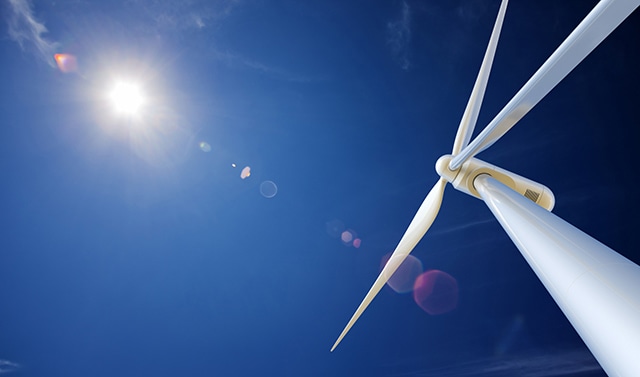
When Forbes recently surveyed green fund money managers, across the board, investors were bullish on graphene. Garvin Jabush, co-founder of Green Alpha Advisors, has predicted the material will transform consumer electronics, telecommunications and the renewable energy sector, among others.
Researchers at Renselaar Polytechnic Institute point to three recent studies showing why graphene is the material of choice to strengthen wind turbine blades. The studies showed that composites strengthened with graphene outperformed carbon nanotube and other nanoparticle composites.
Advanced composites are increasingly used in windmill blades for their ultra-light, ultra-strong properties. Epoxy composites, common in the industry, are brittle and prone to breaking. Researchers found that adding graphene to the epoxy composite at a ratio of 0.1% of the weight of the compound increased the strength by an order of magnitude over a similar amount of carbon nanotubes.
Nikhil Koratkar, professor of mechanical, aerospace and nuclear engineering at Renselaar and head of the studies, describes graphene's unique ability to give its attributes to the materials it's combined with. “Nanotubes are incredibly strong, but they’re of little use mechanically if they don’t transfer their properties to the composite,” Koratkar said, explaining graphene's superior performance.

Incorporating Graphene within Wind Turbine technology could be cost effective for offshore turbines.
Koratkar listed graphene's three advantages over carbon nanotubes: Graphene's rough texture, its expanded surface area and its 2D geometry. Graphene's "wrinkly" surface bonds tightly with surrounding polymers, improving interfacial load transfers. Secondly, a planer sheet of graphene boosts the surface area in contact with the polymers over nanotubes.
Finally, the two-dimensional structure of graphene sheets are superior in deflecting cracks over one-dimensional nanotubes. Researchers hope to use these findings to develop stronger, long-life turbine blades for the wind industry.
Graphene may also play a key role in reducing ongoing operational costs for wind turbines, especially those that are offshore. Batteries have typically been used to power turbine adjustments when wind conditions change. These batteries wear out quickly and are relatively expensive to replace, given turbines' height and remote locations.
Industry leaders are looking to the advances in graphene supercapacitors to supplement or even replace traditional batteries in wind turbines. Their long life and low environmental impact will significantly reduce turbine operating costs.
Graphene has the potential to transform the clean energy industry, although research is still in its infancy the very prospect of incorporating graphene into renewable energy technology is promising.
Be sure to visit AZoNetwork on Facebook to share your views on this technology. You can also follow us on Twitter and ask any questions to our dedicated editorial team using the comments section below.
Image Credit: photos.com
Further Reading: Forbes, National Geographic, Rensselaer, Rensselaer - Graphene Outperforms Carbon Nanotubes